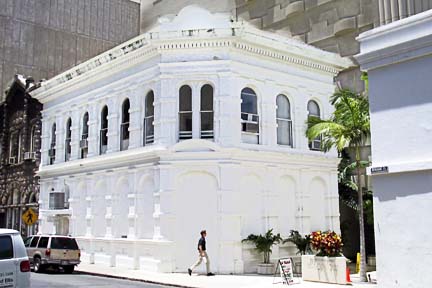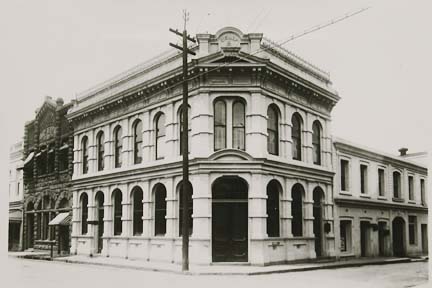
[ A WALKING TOUR ]
Monotone paint job
mars Bishop Bank’s
fine detailAlthough they were built 18 years apart and have quite different architectural styles, there probably aren't two buildings downtown that are closer to each other than the Bishop Estate Building and the Bishop Bank. They almost embrace each other.
Built of brick and stuccoed over, the Renaissance Revival-style Bishop Bank Building features an unusual corner entry that echoes the Royal Saloon up the street. The structure was known for its finely detailed masonry work, with arched windows and doorframes, simulated keystones, articulated brick pilasters -- repeated in the Bishop Estate Building -- a decorative cornice and a fortress-like parapet that gave the building a unique personality.
Already a couple of decades old when it moved into the building in 1878, Bishop Bank is the ancestor of First Hawaiian Bank, one of the largest banks in Hawaii. In 1925, Bishop Bank moved to a much larger beaux-arts building on Bankers Row on Bishop Street and the older building became home to a number of other businesses, primarily lawyers.
The first-floor windows and the distinctive corner entrance have been plastered over to sub-divide the building interior, and many of the distinctive decorative details are lost under the layers of stucco. It doesn't help that the building is painted a white monotone, making it resemble a wedding cake.
Bishop Bank Building
Opened:
1878Architect:
T.J. BakerStyle:
Renaissance RevivalAddress:
63 Merchant StreetNational Register:
1973 (District #73000661)Hawaii Register:
No
BACK TO TOP |
BURL BURLINGAME / BBURLINGAME@STARBULLETIN.COM
Many of the Bishop Bank Building's fine masonry details have been obscured by layers of stucco and paint.
HAWAII STATE ARCHIVES
The Bishop Bank Building featured a distinctive corner entrance on Merchant and Fort Streets that was plastered over when the building's interior was subdivided.
BACK TO TOP |
Quicktime VR Panorama
Click on pictures to view panaromas

BURL BURLINGAME / BBURLINGAME@STARBULLETIN.COM

BURL BURLINGAME / BBURLINGAME@STARBULLETIN.COM
Every Sunday in the Star-Bulletin Travel section, rediscover the charms of old Hawaii through a tour created by the Honolulu Historic Trail Committee and Historic Hawai'i Foundation and supported by the city's Office of Economic Development. The yearlong project commemorates Honolulu's bicentennial.
BACK TO TOP |
See Honolulu City Highlights
Various Honolulu historical organizations have clamored for years to have some sort of survey created of downtown Honolulu's historical sites. The mayor's Office of Economic Development stepped in last year to create order, and 50 locations were chosen as representative of Honolulu's history.
There is, of course, far more history in Honolulu's streets than indicated here, but these sites give the high points and can be visited on a walking tour lasting about three hours.
To commemorate Honolulu's bicentennial, the Star-Bulletin kicks off "Holoholo Honolulu" today, a year-long project to examine these historic properties. For the next 50 Sundays in the Travel section, stories and photographs will illuminate these sites.
But that's just the tip of the architectural iceberg. Viewers can step right into these locations via the magic of QuickTime Virtual Reality, a computer process that allows visitors from around the world to feel as if they're standing right there on the street.
WE'RE ALSO looking for old photographs of these sites to scan for public use. If you have anything, let us know:
Write to:
Holoholo
Honolulu Star-Bulletin
7-210 Waterfront Plaza
500 Ala Moana
Honolulu, HI 96813.E-mail:
bburlingame@starbulletin.com



